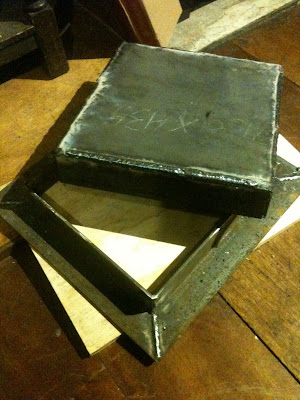The solution we decided on was a Dunsley Yorkshire Multifuel Back Boiler stove which heats the living room but also heats radiators in all the other rooms. We bought the stove, and had an 'interesting' experience carrying it aboard. It weighs about 250kg, and initially we couldn't even shuffle it along the ground, so i got out the spanners and took it all apart, essentially removing everything that could be unbolted (doors, firebricks etc) to reduce the weight as much as possible.

This got us to the point where 4 people could carry it, hung by straps on 2 poles, and so we gingerly carried across 6 barges, hoping desperately that we wouldn't drop it in the river. Luckily we managed to get it safely on board.

and then down the stairs and safely inside and re-constructed

Once it was re-constructed, it was so heavy that we had to make a wheeled trolley to move it around

partly so that we could get it back off the old concrete slab (that we think used to have an Arga on it)

so that we could smash it up, with a hammer drill and cold chisels. This turned out to be a wise decision, as it was pretty badly made, the old 'chuck some bricks and stuff in the hole and pour concrete in' technique. So it was good to get rid of it all.

Of course there was also more unplanned elements to the job. We decided that to do it properly we really needed to do the hull wall behind the stove, so we took the old walls off, stripped the paint, repainted and insulated it all.

The we could make our new hearth. We built a frame, put an 18mm ply top on it, and then topped it with some very nice 120cm square ceramic tile from the excellent London Tile and Mosaic Company who are just down the road from us.




We did try it out as a dancefloor, but ultimately decided to stick with using it as a hearth.


We then attacked the job from two fronts simultaneously. I started plumbing in all the radiators while Lorna sorted out the flue for the stove.
Plumbing:
This took AGES! Days and days of cutting and bending bending pipes, fitting elbows and service valves, plumbing in radiators (we bought a couple of new ones but also re used some old ones, flushing them through until the filthy balck sludge was replaced with clear water



cutting holes through (the top) of a bulkhead to allow the gravity circuit to pass through to the wheelhouse, this is one job that never seemed to end.




And boy did we have to keep buying more stuff too:







But eventually everything was all plumbed in, we poured water into the feeder tank, ran around tightening up all the leaking joints, poured more water, fixed more leaks, and repeated until the system was full and ready to go.
Meanwhile, Lorna was sorting out the flue. There was already a window above where we wanted to put the stove, so she shortened the window part, welding in a lip onto which would sit a double glazed, non opening panel

and fabricating an openable 'hatch', into which the flue would be welded, making it watertight, but removable, if we ever need to clean it, or move the stove.






Then the final step was to make a little support for the double skinned, insulated flue to sit on top


and we were ready to go.
We fired up the stove, watched anxiously as the water heated up, hoping the stove wouldn't explode, but the pipe thermostat turned the pump on, the radiators all heated up, and we did a little happy dance to celebrate a warm winter on serenity!































